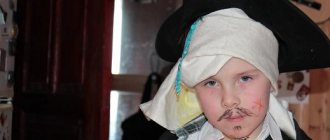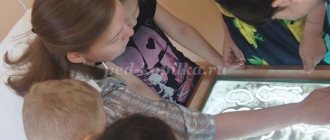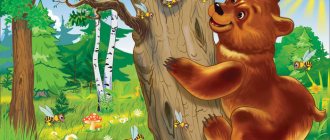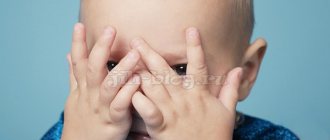Introductory part
Lesson topic: We will go to visit the bear.
Purpose of the lesson: To involve children in joint activities to develop cognitive activity.
Tasks:
- Create an emotional mood, activate children's speech development and vocabulary.
- Strengthen the ability to distinguish between sizes: large, small.
- Practice the ability to correlate the 3 primary colors (yellow, green, red).
- Develop attention, memory, auditory perception.
- Develop cultural, hygienic and self-care skills.
- Cultivate a friendly attitude towards each other.
- Prevent fatigue; create conditions conducive to the development of physical activity.
Dictionary:
- small;
- big;
- cones;
- mugs;
- saucers;
- colors: yellow, red, green.
Material and equipment:
- Teddy Bear toy;
- 2 baskets with cones (large, small);
- colored mugs and saucers;
- laptop;
- audio recordings.
Kindergarten "Kalinka", Volgodonsk
Educational areas: Cognition, communication, socialization.
Types of children's activities: speech, play, motor.
Program content:
- continue to teach children logical thinking using the siriation method (correct assembly of the pyramid);
- find a pair based on two characteristics (large - small and color);
- consolidate knowledge of colors (red, blue, yellow, green);
- Strengthen children's knowledge about wild animals (bear);
- cultivate a friendly attitude between peers, a desire to help each other;
- consolidate children's knowledge about parts of their body.
Goal : to consolidate children’s knowledge of color, shape, size.
Equipment : teddy bear, cubes, dishes.”
Participants : children of the 1st junior group, teacher.
Progress of the lesson
There is a knock on the door and Mishka comes in: I came to visit you and played a little.
Guys: Hello Mishka!
Bear: I slept in my den all winter, and spring came, I woke up and decided to come to visit you and play. Do you know where I live?
Children: In the forest!
Bear: That's right, do you know who else lives in the forest? (Children's answers). Let's listen to the voices of my friends (children identify the voices of animals).
Bear: Oh, guys, you know my friends well by their voices. For this I want to treat you to my favorite delicacy. Do you know what this is?
Children: Yes! Honey!
Educator: Guys, let's also give Mishka a gift, we'll treat him to delicious and sweet tea.
Finger gymnastics “Cabbage” is carried out
A.N. Shchelkunova We chop and chop cabbage. (Together with the child, hit the table top with the edges of your palms)
We three, three carrots. (Clench your hands into fists and rub them together)
We salt the cabbage, salt it. (Make movements simulating sprinkling salt)
And then we press and press. (Clench and unclench your fists)
Bear: Thank you guys, you are so good!
The teacher invites the children to recite A. Barto’s poem “Bear”.
Bear: Oh, guys, show me where my paw is? Eyes? Ears? Nose?
Educator: Mishka, don’t you know the parts of your body at all? The guys and I will help you!
Fizminutka
One, two, three, four, five - let's study the body! Here is the back, and here is the tummy, arms, legs, eyes, nose, mouth, ears, head - I barely managed to shake it. Neck - turns her head, oh, tired oh - oh - oh! The forehead and eyebrows, and the eyelashes, fluttered like birds. Pink cheeks, bumpy chin. The hair is thick, like meadow grass. Shoulders, elbows and knees. With me, Seryozha, Lena!
Bear: Thank you guys, you taught me a lot today.
The teacher invites the children to treat Mishka to tea, but the cups on the table are mixed up. I will give you saucers, and you match them with cups of the same color.
The didactic game “Let’s build a table for Mishka” is being played.
Children treat the bear with tea.
Summarizing
Educator: Children, what did we teach Mishka today? (Children's answers).
Musical pause.
♪♪♪ Let’s dance with the baby to the Zheleznovs’ song “Together with us” (“You clap with us - clap and clap”).♪♪♪
You can listen to the song here.
We perform the movements according to the meaning of the song (they are very simple and obvious).
After you have listened to the song, play a musical instrument with your child .
Turn on any tune that you like, take a few musical instruments that you have at home, and start playing: two minutes on one instrument, two minutes on the second, etc. It is not necessary for the child to get into tune, the process itself is important.
What musical instruments should you offer your child, and what to do if there are none in the house?
You can use special children's musical instruments (tambourine, drum, maracas, spoons, etc.). But if there aren’t any in the house, it’s okay; you can read about what musical instruments are found in any home here: link . (to be honest, my daughter and I most often play “home” musical instruments, and Dasha really likes it. Of the purchased instruments at home, we only have a tambourine and a pipe; it seems to me that other instruments for simple non-professional home music playing need not be bought – after all, there will always be substitutes for them at home).
“Pour the snow over” - development of motor skills.
The essence of the task: the child is offered a bowl filled with “snowball” - semolina, and an empty glass. Mom shows how to pour the cereal with a spoon and asks the baby to do the same. (It is advisable to choose the most beautiful and bright containers that you have in your home - bright and beautiful jars and cups are very attractive to kids).
What does this activity develop?
The game develops the child's fine motor skills and teaches how to use a spoon. The development of fine motor skills in children directly affects the development of speech and overall mental development.
We learn to sort, reinforce the concepts of “big-small”:
The essence of the game: to consolidate in the child’s mind that there are large and small snowflakes in front of him, to sort the snowflakes: large ones into a large “house”, and small ones into a “small” house.
For the game you will need snowflakes of two sizes - large and small (they can be drawn on paper).
To attract the baby's attention and create a “surprise moment,” put on a small show. In front of the child's eyes, with a light movement, throw snowflakes into the air so that they spin beautifully and fall to the floor, attract his attention with your voice: “Oh! Snowflakes are flying! How beautiful they are!”
Carefully examine the snowflakes with your child, draw his attention to the fact that some snowflakes are “so big!”, while others are “so small!”
Prepare “ houses ” for snowflakes in advance - one large and one small (for example, a large plate and a small saucer). Tell your child that the snowflakes want to be taken to the houses - “big snowflakes will go to this big house, and small snowflakes will go to this small house.”
To make it more interesting, snowflakes can be delivered on a truck or carried on a tray, or come up with another unusual way of delivering snowflakes.
What if the child doesn't want to sort?
Perform the sorting yourself, while accompanying all your actions with speech, do it in such a way as to attract the child’s attention. Even this method of completing the task will be beneficial: firstly, the concept of “big-small” will be better fixed in the child’s mind, and secondly, children are big conservatives, and often reject some games and tasks because they seem too “ unknown." It is quite possible that after watching the mother perform the sorting several times, the child will want to “repeat after the mother” next time and will perform all the actions himself.
Educational field: “Cognitive development”.
Tasks.
To develop children’s ability to find objects of the same shape in the environment (circle, triangle, square).
Continue to introduce children to the signs of spring, encourage them to answer the teacher’s questions, repeat individual words and simple sentences after him.
Teach children to draw an image of the sun with a felt-tip pen, draw rays. Fix the yellow color.
Progress of the lesson
Educator:
The sun looks from the sky
And so pure
Good radiant!
If only we could get him
We would kiss him.
The teacher draws attention to the board where there is an image of a large sun with rays and other color illustrations about spring (icicles hanging from roofs, black paths, birds on branches).
Educator:
The sun greets us. Animals, flowers and little children love it when it’s warm, and the sun gives us warmth. It warms us with its rays. The sun is shining brightly because spring has come.
The teacher asks what time of year it is. Children answer one at a time, and then answer in chorus.
The teacher draws the children's attention to the fact that the snow melts on the roofs in the spring and icicles appear. It melts faster on roads and paths. There's less of it there. The snowdrifts turn black and settle. Birds fly in and sing loudly.
The teacher draws the children's attention to the fact that someone is snoring loudly in the house. This is a little bear sleeping, he needs to be woken up. The teacher and the children wake up the bear cub.
Educator:
Children, tell me which teddy bear? Big or small? Children answer (2-3 children).
Educator:
What kind of bed does the bear cub have? Big or small? The teacher encourages them to answer (asks two or three children).
Educator:
The teddy bear is small and the bed is small. Mama bear woke up and went to get food. And I forgot to wake up the little bear. So he sleeps drowsy. This way you can sleep for a long time and sleep through a lot of interesting things.
Physical education lesson about birds
(musical soundtrack).
Educator:
The bear is small and loves to play. Let's take him to kindergarten and teach him to play our games. And here is the magic path.
(The teacher lays out a path of linoleum circles.) The children and the bear cub walk along this path. Hidden in the last circle was a little man with eyes and a mouth. Children, together with the teacher, examine the shape (circle).
Educator:
The little man is very upset; he cannot find round objects. Let's help him find these items in our group.
Children and the teacher find objects and put them in a hoop where a circle man is located.
The teacher pays attention to what figure the found objects resemble.
The same thing happens with a triangle and a square.
If there is difficulty, the teacher searches with the children for objects of the required shape in the group environment.
Educator:
Spring is coming to us
Quick steps
And the snowdrifts melt under her feet,
Black thawed patches are visible in the fields,
You can see very warm feet in spring.
Educator:
Guess who helps spring. Round, bright, affectionate, with rays.
Children answer that it is the sun (individual answers).
Educator:
Let the children draw a sun with rays for the little bear as a souvenir.
The children sit at the tables.
The teacher shows on the easel how to draw the sun with rays.
Children draw the sun with rays in the air.
The teacher distributes sheets of white paper and yellow markers.
Children draw. The teacher comes up and helps those who cannot.
The guys give drawings to the bear cub. He says goodbye to the children and goes to look for his mother.




